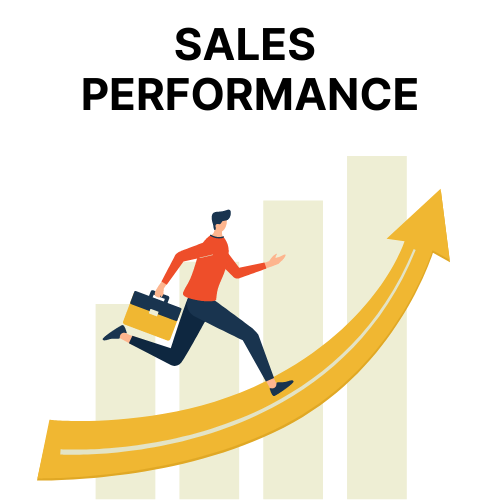9 Surefire Ways to Boost Sales Performance


Selling is hard. It takes resilience, perseverance, and the ability to take a punch or two. Well, probably more than two.
Good sales leaders know how to motivate their team and sustain morale. They also know how to boost customer engagement, leverage data to increase sales, and set sales goals that are aspirational yet attainable.
In other words, good sales leaders devise great sales strategies.
However, building a successful sales strategy in today's diverse, multi-tiered marketplace is becoming increasingly difficult and requires sales leaders to perform a balancing act like no other. They must align various business elements — parts, processes, systems, tools, and people — to deliver a powerful sales strategy that meets (and hopefully exceeds) revenue targets.
Moreover, sales performance is also impacted by an organization's enablement methods, including sales training and content, culture, cross-functional alignment, and customer satisfaction.
Given so many complexities, improving sales performance can be a daunting task. That is why we have listed down 9 surefire ways to boost sales. We hope you find them useful:
On average, it takes 8 cold call attempts before you finally speak to a prospect, before you finally get to pitch your product.
To say you have to make every pitch count, then, seems like a gross understatement. And so we won't say it.
But what we will say is that creating the perfect sales pitch is not so much about flaunting your product's features as it is about showcasing how well those features can fulfill your customer's needs.
Developing an effective sales pitch is one of the most fundamental steps of any sales process. When done right, it forges an instant bond with your customers, gives them a thorough understanding of your product, and, most importantly, leaves them thinking about you long after you've hung up.

No matter how good the script, the best dialogue in a movie will fall flat if the wrong actor is cast.
The same goes for your sales pitch.
To get the most bang for your (sales pitch's) buck, you need to hire the right sales team. This does not mean merely recruiting top talent but also nurturing them periodically with customized training programs.
Hire the right salespeople with industry-specific skills, high levels of motivation and entrepreneurship, and charismatic personality traits. Develop an ideal candidate persona - including traits such as emotional intelligence, team player, a never-say-die attitude, and measure the next bunch of applicants against those metrics.
78% of customers are loyal to brands that fulfill their needs. We'll go one step further and say more than 78% of customers are loyal to brands that fulfill their needs and give them the red carpet treatment each time they walk in — either physically or virtually.
In today's ultra-competitive market, you can no longer entice — let alone retain — customers with the same old, bland, one-size-fits-all bouquet of offers and discounts. You need to come up with innovative promotional campaigns that make each customer feel special.
Every time your customers interact with you, they need to be convinced that your preferences and expectations are your top priority. How can you ensure this? Just remember the golden rule: Customize, personalize, and repeat.
Nothing quite says 'you've got one helluva product' like a satisfied customer. Once your sales team has done the hard bit and converted a prospect into a loyal customer, it's time to reap the fruits of your labor.
How? By setting up a kickass customer referral network.
Your loyal customers are essentially your brand advocates. Even a passing compliment by them about your brand holds more sway than an hour-long pitch by your best salesperson. And that is why you need to incentivize such customers to recommend you to as many of their friends as possible.
Such referrals could be in-person, online, over the phone, or even by post if they so wish. The goal is to establish a seamless referral system that is constantly flooding your CRM with new leads, leading to dramatic improvements in sales performances and helping you build a thriving business.
Your sales model - which is basically how you structure and divide your sales team into smaller groups - massively influences your sales efficiency. Sales models differ between business types, and as companies evolve, they adopt different models depending on what works best for them.
Each model has its own pros and cons, and the one best suited for you will depend upon multiple factors like budget, geography, industry type, culture, and so on.
Will this be a time- and labor-intensive task?
You bet
Then why do it?
Simple. How do you expect to excel in the sales field if your team isn't playing in the ideal formation?
The best sales strategies are fluid and can be easily tweaked to suit ever-changing market dynamics.
To stay ahead of the curve and ensure your sales strategy remains agile, you need to constantly ask yourself questions like:
What new geographies do we want to expand into? What is the buyer persona of our target audience? Are our customers more available on LinkedIn or Instagram? Should we leverage tools like a social media wall to amplify our brand's presence on social media? What type of product positioning will benefit our customers the most?
While the list of questions is endless, the tricky part is figuring out the right ones to ask. If you ever find yourself drawing a blank, round up the entire team for a free-for-all brainstorming session. The results might surprise you.
To start with, you can try using leaderboards and running sales contests.
In an increasingly digitized world, data has become the holy grail of corporate assets. And organizations know this. According to Dell, 80% of companies have adopted digitization over the past year, improving business efficiency.
But there's a problem.
Most companies don't know how to extract the maximum possible value from all the data that's being generated. Challenges also arise when it comes to analyzing and presenting the data, leading to inaccurate reports and conclusions, as well as bad sales decisions.
To better utilize the reams of generated data, companies should start by setting clear, defined goals (e.g., we need to increase the revenue of product X by 30% this year).
Once the goals have been set, the next step should be to ask the right questions (e.g., What are the current revenue sources for product X? What kind of customers buy product X? What's the sales cycle like? What are the price points? What reps are best suited to sell this product?)
Finally, companies can go about collating all their data sets (CRM, invoicing, outreach, etc.) to arrive at a cross-platform, clean trove of data that can accurately answer each of the above questions.
Sales tools make it easier to design effective sales strategies and enhance sales performance. In the process, you also gain key insights into your customers and their buying journeys. Examples of some sales tools available at your disposal are advanced analytics platforms, lead generation providers, and sales management and networking applications like LinkedIn.
You ideally want to choose one that works best for you. A good rule of thumb is to adopt innovative, user-friendly tools that not only fulfill your organizational and team requirements but also map all relevant data needed to make your sales process more rigorous.
Here's a handy list of the best sales tools out there, segmented by categories ranging from CRM, sales enablement, prospecting, engagement, and many more.
Sales enablement involves providing your hardworking sales crew with the resources it needs to close more deals. This includes sales enablement content, sales playbooks, knowledge, training, and any sort of information that will help your sales team become more actionable and hands-on with closures. After all, even superheroes need help sometimes.
Onboarding the right sales enablement approach, however, depends on the size and structure of your organization and your sales requirements.
A well-executed sales strategy is like a well-oiled machine with many moving parts. It yields greater profits, bolsters employee morale, keeps management happy and turns first-time customers into long-time loyalists.
That said, every machine requires maintenance. You must regularly analyze your sales strategy to identify any flaws in the machine, and then promptly make the required changes if you are to consistently clock great sales numbers.